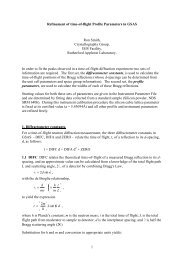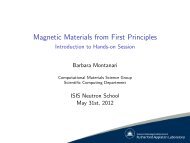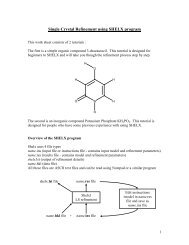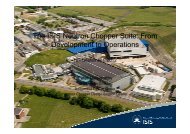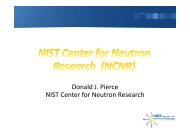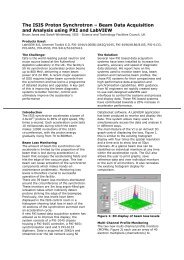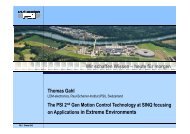CRISP Risk Assessment - ISIS
CRISP Risk Assessment - ISIS
CRISP Risk Assessment - ISIS
You also want an ePaper? Increase the reach of your titles
YUMPU automatically turns print PDFs into web optimized ePapers that Google loves.
Hazard <strong>Assessment</strong> for the <strong>CRISP</strong> Reflectometer in <strong>ISIS</strong> at RAL<br />
The <strong>CRISP</strong> neutron reflectometer is an instrument on the <strong>ISIS</strong> pulsed neutron source at RAL.<br />
The instrument uses a beam of thermal/cold neutrons to probe, by specular reflection the<br />
nature of surfaces and interfaces of thin films.<br />
The reflectometer is located on the N4 beamline and views the liquid hydrogen moderator.<br />
The primary hazard is the neutron beam, which has a maximum dimension of 40x10 mm, and<br />
a thermal/cold flux of
efore the solenoid is energised. Once the “green box” is activated and key released, an<br />
integral switch within the box senses the key has been removed and prevents the beam shutter<br />
from being opened. Any attempt to open the beam shutter before the interlocks are made, or<br />
any malfunction causes the accelerator to trip and therefore remove the source of the<br />
radiation. A radiation monitor in the chopper enclosure provides an additional interlock.<br />
Blue fluorescent lamps are visible in the experimental area when radiation is present. Lamps<br />
indicating the interlock status are also visible from the access gate. Two emergency “beamoff”<br />
buttons are provided in the experimental enclosure, which trips the accelerator when<br />
activated. The access door can only be closed when the 'search' button has been pushed.<br />
Permit to work<br />
For the removable shielding blocks of the chopper enclosure the crane lifting points are<br />
“locked off” by keys held in the MCR key-press and interlocked with a Fortress Interlock<br />
key. Access can only be gained using a “permit to work”. This requires the shutter to be<br />
locked off by the Duty Officer in the closed position, and can only be released when the<br />
shielding has been replaced, locks replaced and an inspection carried out.<br />
Enclosed Experimental Area<br />
‘The experimental enclosure is sealed and air conditioned. The access doors can be opened<br />
from within the enclosure, and will cause the accelerator to trip if the interlocks are enabled.<br />
The air-conditioning has a continual supply of filtered air, the status of which is displayed: an<br />
oxygen monitor is installed within the enclosure with the alarm located outside the access<br />
door.<br />
Alignment Laser<br />
Within the experimental enclosure there is a 3mW solid state laser (670 nm wavelength) for<br />
sample alignment. The installation is in accordance with current regulations for Class IIIa<br />
lasers. The laser power supply is connected through a “Warning Laser On” light at the<br />
enclosure entrance, and the appropriate warning notices are displayed.<br />
Magnet and Cryostat<br />
Two electromagnets are currently available on <strong>CRISP</strong> to provide magnetic fields in the range<br />
0
low risk of hazards. Contact with cryofluids (liquid helium and nitrogen) represents a risk of<br />
burns to exposed skin. Only experienced technicians and <strong>CRISP</strong> instrument staff fill the<br />
cryostat with cryofluids.<br />
DG Bucknall<br />
12 February 1997<br />
Updated: S. Langridge January 2001




